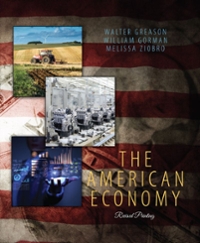Question
(1.)The M1 definition of money includes __________. a.) physical currency only b.) physical currency and demand deposits c.) demand deposits only d.) demand deposits and
(1.)The M1 definition of money includes __________.
- a.)
- physical currency only
- b.)
- physical currency and demand deposits
- c.)
- demand deposits only
- d.)
- demand deposits and time deposits
(2.) If the reserve requirement of a bank is 25%, then the multiplier effect will be ________ and $200 in M1 will increase the money supply by ________.
- a.)
- 25; $50
- b.)
- 4; $800
- c.)
- 4; $50
- d.)
- 25; $800
(3.)Which statement is NOT true regarding the way that the Federal Reservecontrols the money supply?
- a.)
- The U.S. Treasury sends the money it prints directly into circulation.
- b.)
- Money that is printed by the Bureau of Printing and Engraving is turned over to the Fed.
- c.)
- If the Fed wants to reduce the money supply, it sells bonds and shreds the money it receives.
- d.)
- The Fed gives bondholders cash in exchange for securities (bonds).
(4.) Which of the followingstatements is true as it relates to banks and the federal funds market?
- a.)
- The FOMC uses taxation to control our money supply.
- b.)
- The federal funds rate is charged on an annual basis.
- c.)
- Banks with less than the reserve requirement need overnight loans to meet their obligations.
- d.)
- The federal funds market developed as banks lost customers.
(5.) Which statement below is true about the discount rate?
- a.)
- It is the rate that banks charge other banks to loan money overnight.
- b.)
- It is the same as the fed funds rate.
- c.)
- This is the rate used when banks borrow directly from the Fed.
- d.)
- It is the interest rate that the federal government pays to the public via the sale of Treasury securities.
(6.) Which of the following statements is associated withdeflation?
- a.)
- Prices fall, but loan payments stay the same.
- b.)
- Prices increase so quickly that it hurts trade.
- c.)
- In extreme cases, this can force people to revert back to a barter economy.
- d.)
- It decreases the real value of debt.
(7.) Which of the following is associated with contractionary monetary policy?
- a.)
- Increasing taxes
- b.)
- Lowering the discount rate
- c.)
- Buying Federal Treasury bonds
- d.)
- Increasing the reserve requirement
Step by Step Solution
There are 3 Steps involved in it
Step: 1

Get Instant Access to Expert-Tailored Solutions
See step-by-step solutions with expert insights and AI powered tools for academic success
Step: 2

Step: 3

Ace Your Homework with AI
Get the answers you need in no time with our AI-driven, step-by-step assistance
Get Started


